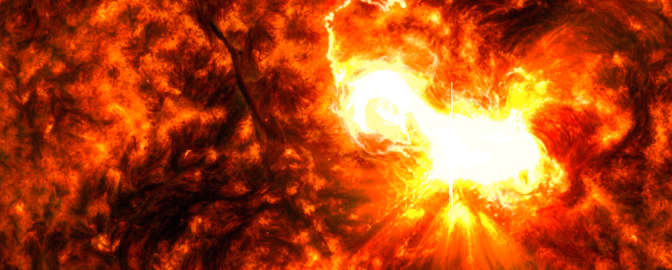Multiple views of comet ISON from solar-observing spacecraft

Written by
Emily Lakdawalla
December 2, 2013
Once ISON passed through perihelion last week I realized that it was silly for me to try to keep updating animations throughout the weekend -- that the best course of action would be patience, to wait for spacecraft data sets to build up to provide complete views of the comet's perilous plunge past the Sun. And now I've spent a solid six or more hours downloading, stacking, and animating solar spacecraft data. To whet your appetite, here's the latest version of the STEREO A approach movie, watching the comet as it approaches the Sun, which is just off camera to the right.

There are three spacecraft whose views I'll be sharing with you. One is SOHO, or the Solar and Heliospheric Observatory, a joint project of ESA and NASA. You can download SOHO data here. The other two are STEREO, NASA's Solar TErrestrial RElations Observatory. You can download STEREO data here. STEREO consists of two spacecraft, one drifting Ahead and one drifting Behind Earth, conveniently named STEREO Ahead and STEREO Behind or just STEREO A and B. The STEREO spacecraft are now actually approaching each other, only about 60 degrees apart on the far side of the Sun from Earth, with B slightly farther from the Sun than A. Here's a view of their current positions with respect to Earth:
SOHO is located at the Sun-Earth L1 point, effectively the same position as the Earth in the diagram above.
All three of these spacecraft have coronagraphs. These are telescopes equipped with an occulting disk to block out the Sun, making an artificial eclipse that allows the camera to see fainter phenomena. Those fainter phenomena can be related to the Sun (like coronal mass ejections, for instance) or they may be background stars. Once in a while, moving objects like planets and comets wander into the coronagraph fields of view. (For more on what a coronagraph is and how it works, visit spaceweather.com.)
Now compare the positions of the STEREO and SOHO spacecraft in the diagram above to this little animation of ISON's orbit, which I made using JPL's neato orbit diagram viewer. It's basically the same perspective as above, looking down on the solar system from the north. The light blue part of ISON's orbit is above the plane of Earth's orbit. The dark blue part is below the plane. You can see that STEREO Behind was viewing the comet coming almost straight-on, while STEREO Ahead was viewing it almost exactly from the side. That produced major differences in the comet's appearance to the two spacecraft. SOHO had a more oblique view than either of the others.
Okay, so let's begin by looking at that cool approach movie taken by STEREO Ahead. This one was viewing the comet from the side -- almost all of its motion is in the plane of STEREO Ahead's view.
Before I show you the rest of the animations, I want to talk to you about phase angle. Phase angle is the angle from the Sun, to an object in the solar system, to your eye (or the detector on a spacecraft). When the phase angle is zero, the Sun is right behind you, shining directly on the object. When phase angle is 180 degrees, the Sun is directly in front of you, with the object in between you and the Sun. Phase angle has a strong effect on how bright an object appears, and it works counterintuitively for comets. For solid things like icy moons, they get dimmer as phase angle increases:

But for things that consist of clouds of dust or haze particles, like comet tails and Saturn's rings and the upper atmospheres of planets and moons, something funny happens at very high phase angles: forward scattering. Tiny particles start scattering light forward to your eyes, and they get brighter:

As comet ISON rounded the Sun, the phase angle at which we were observing it changed very rapidly, and just how it changed was different for each one of these three observers.
I'll start with SOHO, because that's the easiest one to picture; it has the point of view of Earthly observers. When the comet first appears at lower right, it is in between Earth and the Sun -- a good geometry for forward scattering. The comet's dusty tail is very bright. At some point very near perihelion, it passes to the far side of the Sun as seen from Earth, a geometry in which the tail is more difficult to see. Some time after passing through perihelion, it comes back to being in between Earth and the Sun, a better geometry for lighting up the tail. From the JPL orbit diagram applet it seems to me that it spent the time from roughly 16:00 to 23:00 on November 28 behind the Sun as seen from Earth. It seems to be fading but hasn't faded completely by the end of the animation.
For completeness, here's a view of what happens very close to perihelion, from SOHO's other camera, LASCO C2. LASCO C2 has a smaller field of view than C3 (3 degrees as compared to 16 degrees). After perihelion, the comet appears quite faint, but I'm now wondering how much of that is a phase angle effect, considering that the part of the comet's orbit that we can see after perihelion is all on the far side of the Sun as seen from Earth.
Okay, let's move on to STEREO Ahead. I showed you the approach movie already. From the STEREO Ahead spacecraft, we have a side view of the comet's orbit, so phase angle effects are much less of an issue. The comet is slightly closer to STEREO Ahead on the inbound leg, and farther on the outbound leg, so you would expect the tail to be somewhat brighter inbound than outbound no matter what happened to the comet at perihelion. I also realized that because we have this side view, the comet actually hardly disappears behind the coronagraph -- it's partially visible the whole time.
The view from STEREO Behind is much different. The comet is approaching STEREO almost head-on. That's why it appears to move so slowly -- almost all of its motion is right at STEREO. Consequently, its tail is foreshortened. It is also on the far side of the Sun as seen from the spacecraft on approach, which means we're seeing it at low phase angle; it's all reflected light. Then it disappears behind the coronagraph as it rounds the Sun, and then BOOM! It's intensely bright as it reappears. It's almost exactly in between the Sun and STEREO Behind, so we're seeing light forward scattering from the cloud of dust that makes up the coma. But it recedes again, moving up and away from STEREO after perihelion, returning to the far side of the Sun.
And now...I am nearly blind from staring at solar images all day! I've learned that at least some of the variation that we're seeing in the comet's brightness over time has to do with phase angle effects. Of course, there is a lot of other stuff going on, not the least of which is the fact that it was a giant dirty iceball that approached close enough to the Sun for the rocky component of its dust to vaporize. I'm looking forward to what scientists have to say about what happened to the comet as it passed through perihelion, and what that tells us about Oort cloud comets. And what that, in turn, has to tell us about the formation of the solar system in the first place.
Breakthrough research starts with YOU!
Your support will empower the next round of STEP grant winners. Make your gift today to fund tomorrow's promising science and technology projects.
Donate

 Explore Worlds
Explore Worlds Find Life
Find Life Defend Earth
Defend Earth

